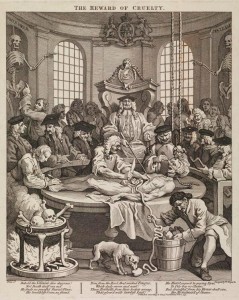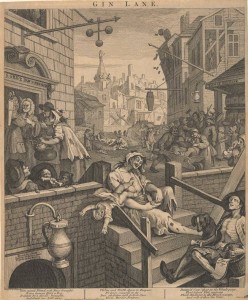The interaction of art and science in the Print Collection
Working at the University of Melbourne’s Print Collection as part of the 2016 International Museum and Collections Award was like entering a veritable Aladdin’s cave of riches for a recent Art History Graduate like me. Although the shelves are stacked with plenty of treasures for me to feast my eyes on, I was particularly struck by The Reward of Cruelty which is part of a series of four engravings entitled ‘The Four Stages of Cruelty’ by William Hogarth and was published in 1751.
William Hogarth, The Reward of Cruelty, 1751, engraving, plate: 38.8 x 31.8 cm, Purchased, 1995, Baillieu Library Print Collection, the University of Melbourne.
I was familiar with both Hogarth’s Gin Lane and A Harlot’s Progress with their satire of English 18th century life and their motive to serve as a warning to the lower classes. Each image is clearly designed to emphasis morals (or the absence thereof) and demonstrates the downfall of those who spend their lives courting vice, whether through drinking, prostitution or gambling.
In one sense, The Reward of Cruelty can be seen in a similar vein, offering a deterrent to those who may choose a life of criminality by highlighting the consequences—ultimately, a public execution and a body which will be dissected and thus denied a Christian burial and place in the afterlife.
William Hogarth, Gin Lane, 1751, engraving, image: 35.3 x 30.2cm, Gift of Dr J. Orde Poynton, 1959, Baillieu Library Print Collection, the University of Melbourne.
William Hogarth, Apprehended by a magistrate, (1732), engraving, plate: 22.7 x 37.9cm, Gift of Dr J. Orde Poynton, 1959, Baillieu Library Print Collection, the University of Melbourne.
Yet this image is macabre and perhaps propagandistic to the extreme, suggesting not only an undignified end to those who submit to a life of crime but also demonstrating the then popular suspicion of surgeons and a distaste for this practice of anatomisation.
Here the dissectors at hand are portrayed as vultures surrounding a carcass, quick to begin their preparations despite the fact the hangman’s noose has not yet been removed from the body, thereby signalling that their subject may in fact still be alive. They are devoid of humanity or caring and the crowds suggest this public spectacle is one of entertainment rather than to further the pursuit of medical knowledge. Hogarth succeeds in not only creating a grim warning that plays upon the steadfast religious attitudes of the era but also an image which demonstrates public distrust of contemporary medical advancements.
This contrasts vividly with another print in the collection: that of Johannes Pieter de Frey’s etching after Rembrandt The anatomy lesson (1798). In this image the surgeons seem more focused upon the book in front of them rather than the cadaver; they appear scholarly and sensible, studying their text instead of launching into the dissection. The composition of the print draws parallels with the motif of the depiction of the lamentation of Christ and emphasises that although this body is also of a criminal denied a Christian burial, this sacrifice is necessary for the furthering of scientific knowledge.
Johannes Pieter de Frey after Rembrandt van Rijn, The anatomy lesson, (1789), etching, image: 28.1 x 36.2 cm, Gift of Dr J. Orde Poynton, 1959, Baillieu Library Print Collection, the University of Melbourne.
It is this intersection between both art and science that can be traced throughout these prints and offers a different way of contemplating this collection.
These prints, alongside many other examples by artists such as Claude Lorrain, Francisco De Goya and Rembrandt, are available to study and view on request in the Baillieu Library Reading Room.
To learn more about the Museums and Collections Award please see:
Emily Robins – intern at University of Melbourne’s Collections
International Museums and Collections Award
For further reading please see:
Fiona Haslam, From Hogarth to Rowlandson: Medicine in Art in Eighteenth-century Britain. Liverpool: Liverpool University Press, 1996
Emily Robins
International Museums and Collections Award Recipient 2016




Leave a Reply